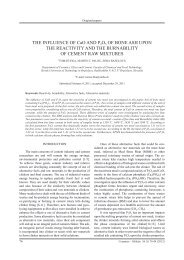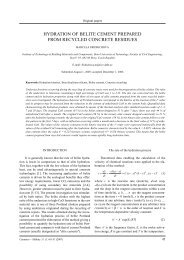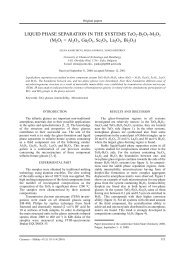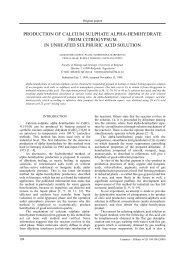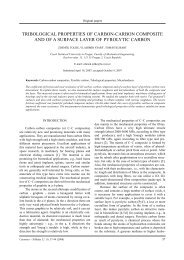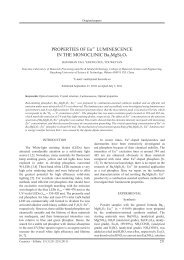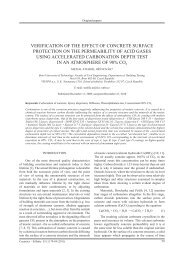behaviour of alumina-spinel self-flowing castables - Ceramics-Silikaty
behaviour of alumina-spinel self-flowing castables - Ceramics-Silikaty
behaviour of alumina-spinel self-flowing castables - Ceramics-Silikaty
You also want an ePaper? Increase the reach of your titles
YUMPU automatically turns print PDFs into web optimized ePapers that Google loves.
Behaviour <strong>of</strong> <strong>alumina</strong>-<strong>spinel</strong> <strong>self</strong>-<strong>flowing</strong> <strong>castables</strong> with nano-<strong>alumina</strong> particles addition<br />
<strong>castables</strong>, reactive <strong>alumina</strong> is substituted by nano-<strong>alumina</strong><br />
powder in 0-4 wt.% range. The TEM micrograph<br />
<strong>of</strong> nano-<strong>alumina</strong> consumed is shown in Figure 1.<br />
The Particle size distribution was calculated from<br />
the Andreasen‘s equation (1) as follow:<br />
CPFT = 100 × (d/D) q (1)<br />
where CPFT, d, D and q indicate the cumulative percentage<br />
finer than, particle size, the largest particle size<br />
(5000 μm) and the distribution modulus, respectively. In<br />
order to achieve <strong>self</strong>-flow, q values should be in the range<br />
0.21-0.26. The q = 0.24 was considered for the present<br />
study, with respect to our previous investigations [5]. The<br />
particle size distribution <strong>of</strong> the castable with this value<br />
<strong>of</strong> q and without nano-<strong>alumina</strong> particles is represented<br />
in Figure 2.<br />
Self-flow measurement<br />
Self-flow value and working time measurement<br />
was performed according to ASTM C 1446-99. Based<br />
on this standard, after dry mixing <strong>of</strong> the batch for 30 s<br />
in a planetary mixer (Hobart), all the water (distilled)<br />
was added within 10 s while the mixer was running. The<br />
Table 1. Raw materials and composition <strong>of</strong> the studied <strong>alumina</strong><strong>spinel</strong><br />
castable.<br />
Raw materials Source (Type) (wt.%)<br />
Tabular Alumina .. 2-5 mm<br />
............................. 1-2 mm<br />
.......................... 0.5-1 mm<br />
.......................... 0-0.5 mm<br />
............................ ≤ 45 μm<br />
Alcoa Chemicals, T-60 ............60<br />
Spinel ............... 0.5-1 mm<br />
.......................... 0-0.5 mm<br />
White Circle, Spinwhite 78 .....23<br />
Reactive .... d50 = 1.90 μm<br />
Alumina<br />
Alcoa Chemicals, CTC-20 ......11<br />
Cement ...... d50= 3.03 μm Lafarge, Secar-71 ......................6<br />
Deflocculant ..................... S.K.W., Castament FS 10 .......0.1<br />
Table 2. Chemical composition <strong>of</strong> used raw materials.<br />
Oxide Tabular Spinel Reactive Cement<br />
(wt.%) Alumina Alumina<br />
Al2O3 99.4 76-77 99.8 72.7<br />
Na2O 0.36 0.15 0.06 0.19<br />
CaO 0.05 0.3 0.02 26.5<br />
MgO 0.1 22-23 0.02 0.09<br />
SiO2 0.02 0.06 0.03 0.2<br />
Fe2O3 0.1 0.1 0.03 0.01<br />
Table 3. Chemical composition and physical parameters <strong>of</strong><br />
nano-<strong>alumina</strong>.<br />
Al2O3 Specific surface Crystal Loose density Average grain<br />
(%) area (m2 /g) phase (g/cm3 ) size (nm)<br />
99.99 35 α 0.33 43<br />
wet mixing was conducted for 5 min at a slow speed<br />
(Hobart, speed 1). After mixing, the prepared castable,<br />
was transferred to a sealed container and care was<br />
taken to keep the moisture constant. Ten minutes after<br />
addition <strong>of</strong> water, the mixed castable was poured into a<br />
standard cone with a base diameter <strong>of</strong> 100 mm according<br />
to ASTM standard number C-230. The cone was then<br />
elevated to allow the mix to flow, and after 60 s the<br />
patty diameter was measured. The percentage increase<br />
in spreading diameter after 60 s is taken as the <strong>self</strong>-flow<br />
value according to the following Equation (2):<br />
Self-flow (%) = (D2 – D1) ×100/D1 (2)<br />
where D2 is the final average diameter after removal <strong>of</strong><br />
mould and D1 is the initial diameter (100 mm). The castable<br />
is considered as <strong>self</strong>-flow, when the above value<br />
lies within the range <strong>of</strong> 80-110 % <strong>of</strong> the base diameter.<br />
During the <strong>self</strong>-flow evaluation, the ambient temperature<br />
was controlled to be in the range <strong>of</strong> 20-24°C [12].<br />
Figure 1. TEM image <strong>of</strong> nano-<strong>alumina</strong> particles.<br />
10 nm<br />
Figure 2. Theoretical and experimental particle size distribution<br />
<strong>of</strong> <strong>self</strong>-<strong>flowing</strong> castable without nano-<strong>alumina</strong> particles.<br />
<strong>Ceramics</strong> – Silikáty 53 (2) 98-101 (2009) 99



